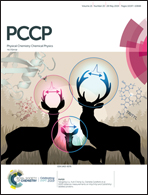Determination of element–deuterium bond lengths in Zintl phase deuterides by 2H-NMR†
Abstract
The Zintl phase deuterides CaSiD4/3, SrSiD5/3, BaSiD2, SrGeD4/3, BaGeD5/3 and BaSnD4/3 were investigated by nuclear magnetic resonance (NMR) spectroscopy and density functional theory (DFT) calculations to reliably determine element–deuterium bond lengths. These compounds show deuterium bound to the polyanion and deuteride ions in tetrahedral cationic voids. With 2H-NMR experiments we characterised the individual signals of the two distinct crystal sites. Quadrupolar coupling constants (CQ) of the anion-binding site were determined as 58 to 78 kHz (Si compounds), 51 to 61 kHz (Ge compounds) and 38 kHz (Sn compound). These values agree well with the quadrupole couplings derived from DFT using optimized structural models. We further calculated the general element–deuterium distance dependency of CQ using DFT methods that allow an accurate determination of bond lengths via the 2H quadrupole interaction. The thus determined bond lengths are evaluated as d(Si–D) = 1.53–1.59 Å, d(Ge–D) = 1.61–1.65 Å and d(Sn–D) = 1.86 Å. Chemical shifts of the anion-binding site range from 0.3 to 1.3 ppm. The isotropic chemical shifts of the tetrahedral sites are 5.1 ppm (CaSiD4/3), 7.0 to 10.0 ppm (Sr compounds) and 10.7 to 11.6 ppm (Ba compounds).



 Please wait while we load your content...
Please wait while we load your content...